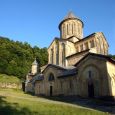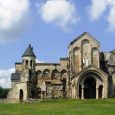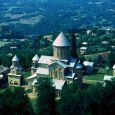Kutaisi
Advertisement
By train
There is a daily train connection from Tbilisi with Georgian Railways, the train departs at 9:05AM and arrives just under six hours later at 2:50PM. A ticket with reserved seat costs 5 GEL.
By bus
Mini-buses (marshrutkas) and full 54-passenger buses depart regularly for Kutaisi from Ortachala Bus Station located at the Didube metro stop in Tbilisi. Marshrutkas typically depart once an hour; large buses every three hours. Typical fare is 10 lari. Travel by marshrutkas takes roughly 3.5 hours; larger buses take slightly longer due to more frequent stops.
Go to the last stop north in the Tbilisi metro, after you exit the market there will be plenty of buses to take you to Kutaisi.
Advertisement
Bagrati Cathedral
The Cathedral of the Dormition, or the Kutaisi Cathedral, more commonly known as Bagrati Cathedral, is the 11th-century cathedral church in the city of Kutaisi, the region of Imereti, Georgia. The cathedral, now in ruins, is regarded as a masterpiece in the history of medieval Georgian architecture.
A distinct landmark in the scenery of central Kutaisi, the cathedral rests upon the top of Uk’imerioni Hill. It was built in the early years of the 11th century, during the reign of King Bagrat III due to which it was called "Bagrati" Cathedral, i.e., Bagrat’s cathedral. An inscription on the north wall reveals that the floor was laid in "chronicon 223", i.e., 1003. In 1692, it was devastated in an explosion by the Ottoman troops, which had invaded the Kingdom of Imereti. The incident caused the cupola and ceiling to collapse leaving the cathedral in its present state.
Gelati Monastery
The Monastery of Gelati is a monastic complex near Kutaisi, Imereti, western Georgia. It contains the Church of the Virgin founded by the King of Georgia David the Builder in 1106, and the 13th-century churches of St George and St Nicholas.The Gelati Monastery for a long time was one of the main cultural and intellectual centers in Georgia. It had an Academy which employed some of the most celebrated Georgian scientists, theologians and philosophers, many of whom had previously been active at various orthodox monasteries abroad or at the Mangan Academy in Constantinople. Among the scientists were such celebrated scholars as Ioane Petritsi and Arsen Ikaltoeli.
Due to the extensive work carried out by the Gelati Academy, people of the time called it "a new Hellas" and "a second Athos".
Geguti
Geguti is a Georgian medieval royal palace, now in ruins, at the omonymous village, 7 km south of the city of Kutaisi, Georgia.
The ruins of the Geguti palace complex occupy the area of over 2,000 m2 along the Rioni River. An extensive fieldwork between 1953 and 1956 allowed the specialists to stratify the principal archaeological layers and reconstruct the architectural form and decoration of the medieval edifices bulk of which dates to the 12th century, the period when the first written mention of Geguti appears in the Georgian Chronicle. The earliest structure – a plain, one-room building with a large fireplace – dates back to the 8th/9th century. A principal part of the royal complex, commissioned by King George III of Georgia (r. 1156-1184), is a four-tier brick edifice built onto a three-metre high stone plinth, with its spacious, cruciform central hall surmounted by a dome 14 m in diameter resting on squinches. The entire building is walled and fortified with massive pillars. Westerly located additional structures and a palace church are of a later period, dating to the 13th/14th century.
Information not available
Information not available
Advertisement







